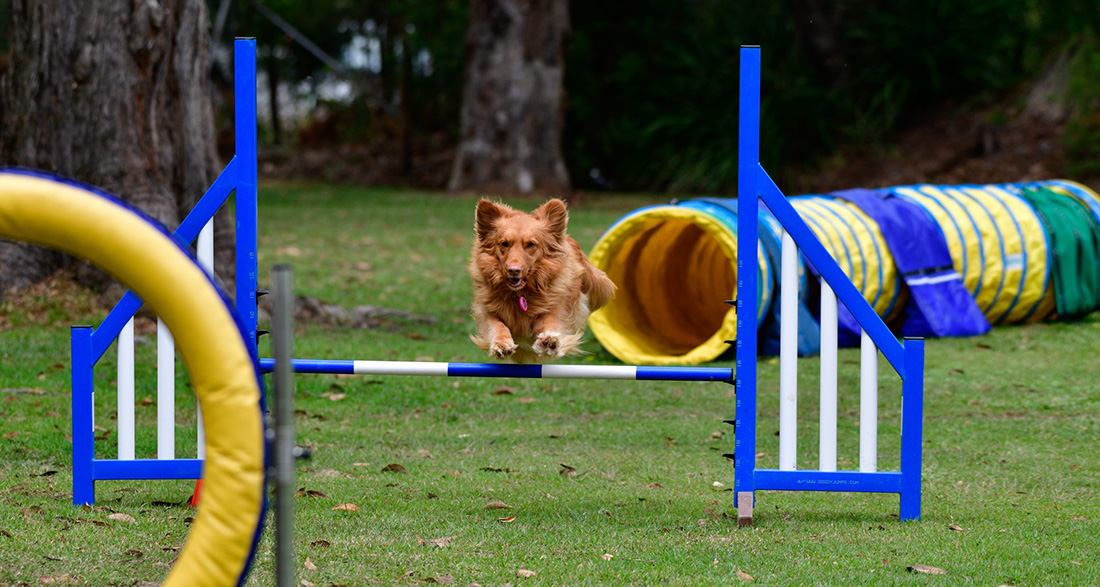You know and are enthusiastic about the dog sport Agility, where dogs are guided through a course to demonstrate their agility and speed? But perhaps your old or handicapped dog cannot meet such demands? That’s no reason to give up, as Degility offers excellent balance sport for dogs and is tailored to each individual dog. Read on to discover the benefits of Degility for your dog!
Degility – for the Sake of Your Dog
Degility is a canine sport based on Agility exercises but focuses more on dogs with disabilities and breed-specific limitations. Particularly large breeds struggle with joint problems and should avoid strenuous dog sports. However, even small dogs may not be able to handle all the obstacles and tasks of an Agility course. Conversely, overactive, nervous, and aggressive dogs should not be “exhausted” by biking or Agility training but need calming and task-oriented exercises.
Degility slows down and simplifies the Agility course, catering to your dog’s individual needs. The concept of Degility primarily involves stress-free, species-appropriate training that strengthens and challenges the dog’s muscles, coordination, and memory.
Unlike Agility or Mobility, Degility proceeds slowly, but the strength of the training lies in its slowness. You’ll be amazed that slow exercises challenge your dog more effectively and sustainably than a fast run through the course. Unlike Agility, the philosophy of Degility canine sport is not to stimulate the dog’s “sportsmanship” but to build motivation for task-oriented movement.
Goals of Degility Training
There’s no pressure to perform in Degility. The course is designed so that every dog can handle it and have fun. Degility training has many positive effects on the well-being of the dog and is recommended by many animal therapists, canine physiologists, and canine psychologists as a species-appropriate and gentle dog sport.
Goals and benefits at a glance:
- General strengthening of conditioning
- Species-appropriate satisfaction of the dog’s need for movement
- Building and strengthening muscles
- Joint-friendly movement
- Promotion of mental abilities
- Boosting confidence in fearful dogs
- Promotion of coordination skills
- Stress relief for aggressive and under-stimulated dogs
- Strengthening the bond between dog and owner
While Agility is only suitable for healthy, fit, and particularly active (working) dogs, Degility is suitable for all dogs. Animal therapists emphasize the balancing effect of training on stressed, aggressive, but also insecure and fearful dogs. Dogs with stress symptoms or under-stimulated “couch potatoes” with poor conditioning are gently introduced to tasks in Degility that primarily offer them “brain work.”
Since all stations of the course are completed together by dog and owner, Degility is ideal for strengthening the bond between dog and owner. Especially for fearful, shy, and inadequately socialized dogs, this can be a wonderful opportunity to build the dog’s confidence in itself and simultaneously in you.
What should be considered?
First and foremost: Every exercise and especially the entire course should be tailored to your dog’s current fitness level and, if applicable, their handicap. Neither time nor precision in the execution of exercises are important in Degility. Degility should be fun for your dog and strengthen them both physically and mentally. Therefore, avoid any kind of pressure to perform and introduce your dog to a task in a way that motivates them. Start with simple yet interesting exercises. Avoid fundamentally difficult tasks, as they pose a significant stress factor for dogs.
Your dog should be able to stop the exercise at any time. Nevertheless, give your dog the feeling that he is performing each exercise brilliantly. Develop a sensitivity to what your dog dislikes and when you should possibly interrupt the exercise. If your dog cannot handle an exercise, hesitates, or shows uncertain behavior, do not motivate them for too long. End the exercise in time before it stresses your dog.
If an exercise is terminated prematurely, reassure your dog afterward that it’s not a big deal: Immediately switch to a simpler exercise that they already know and praise them effusively. This way, your dog always receives positive feedback that reinforces their efforts, rather than frustrating them. Particularly fearful and insecure dogs benefit greatly from this.
Degility Course: Design it Yourself or Go to Dog School?
In theory, there’s nothing wrong with building a Degility course yourself, provided your garden has sufficient space and you have been introduced to the required know-how of Degility training by a professional dog trainer. However, the self-construction of individual stations and exercise equipment can quickly overwhelm even a skilled DIY enthusiast. Moreover, inaccurately constructed course stations pose dangerous injury risks for your dog. It is therefore advisable to only visit professionally built Degility facilities. Nowadays, some cities and municipalities offer special “dog playgrounds” that include individual Degility equipment. Your city administration will have information about this.
However, the best choice remains the dog school specialized in Degility. Here, tailored tasks are offered to your dog. You, on the other hand, learn how to approach individual Degility exercises in a species-appropriate manner and how to properly motivate your dog. In addition, there’s the important exchange with other dog owners. Tips and tricks from experts are included.
For those who have a healthy and agile working dog, Agility training can certainly be considered.
We have compiled some information for you on the topic of “Dog Agility“.


